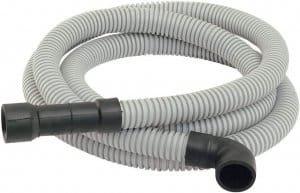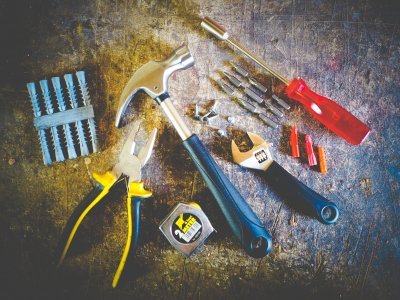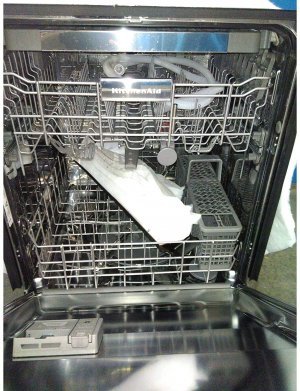Installing a dishwasher drain hose may seem like a daunting task, but with the right guidance and tools, you can do it yourself. In this article, we will walk you through the process of installing a dishwasher drain hose, from choosing the right hose to troubleshooting common issues. So let’s get started and ensure your dishwasher drains properly without any hassles.
A dishwasher drain hose is a vital component that allows the water to flow out from the dishwasher into the sink or garbage disposal. It plays a crucial role in maintaining proper drainage and preventing water leaks in your kitchen. Whether you’re replacing an old hose or installing a new dishwasher, understanding the process will help you complete the task efficiently.
Table of Contents
Why is a Dishwasher Drain Hose Important?
The dishwasher drain hose serves as a conduit for wastewater to leave the dishwasher and flow into the plumbing system. It prevents dirty water from pooling inside the dishwasher and keeps your kitchen clean and hygienic. A well-functioning drain hose ensures that your dishwasher operates smoothly and effectively, preventing potential damage or flooding.
How to Install Dishwasher Drain Hose?
Having a properly installed dishwasher drain hose is crucial for several reasons. First and foremost, it ensures the smooth flow of wastewater out of the dishwasher, preventing any blockages or backups. A correctly installed drain hose also helps to prevent leaks, which can cause water damage to your kitchen floor and cabinets. Additionally, a well-installed drain hose promotes proper drainage, which is essential for the dishwasher to function optimally and efficiently.
Step 1: Prepare the Dishwasher
Before installing the new drain hose, make sure to turn off the dishwasher’s power supply. Locate the dishwasher’s electrical connection and unplug it or switch off the circuit breaker. This precautionary step ensures your safety during the installation process.
Step 2: Access the Drain Hose
To access the drain hose, you may need to remove the dishwasher’s lower access panel or kick plate. Use a screwdriver or the appropriate tool to remove any screws securing the panel. Gently pull the panel away to expose the dishwasher’s interior.
Step 3: Disconnect the Old Drain Hose
Locate the drain hose connection point on the dishwasher’s drain pump or sump. Depending on the dishwasher model, you may need to use pliers or an adjustable wrench to loosen the clamp securing the hose. Once the clamp is loose, detach the old drain hose from the dishwasher.
Step 4: Install the New Drain Hose
Take the new dishwasher drain hose and connect one end to the drain pump or sump. Ensure a secure fit by tightening the clamp with pliers or an adjustable wrench. Be cautious not to overtighten, as it may damage the hose or fittings.

Step 5: Secure the Drain Hose
Next, route the drain hose to the appropriate drain opening in your kitchen. Avoid kinks or sharp bends that could restrict the flow of water. If necessary, use zip ties or clamps to secure the drain hose to nearby pipes or structures, ensuring it remains in place during operation.
Step 6: Test for Leaks
With the drain hose properly installed and secured, it’s essential to test for any leaks before reassembling the dishwasher. Slowly turn on the water supply and observe the connections and the entire length of the drain hose for any signs of leakage. If you notice any leaks, tighten the fittings or clamps as needed.
Step 7: Reassemble the Dishwasher
Once you are confident that there are no leaks, reassemble the dishwasher by replacing the lower access panel or kick plate. Use the screwdriver or appropriate tool to secure the panel with the screws you removed earlier.
Additional Tips and Precautions
- Follow the manufacturer’s instructions and guidelines specific to your dishwasher model.
- Ensure that the drain hose is not positioned too high or too low, as it may impact the dishwasher’s drainage performance.
- Regularly inspect the drain hose for signs of wear or damage. Replace it if necessary to prevent leaks or blockages.
- Consider using a drain hose extension kit if the distance between the dishwasher and the drain opening is too far for the provided hose length.
Types of Dishwasher Drain Hoses
Before installing a dishwasher drain hose, it’s important to choose the right type based on your specific requirements. Here are three common types of dishwasher drain hoses available:
Flexible Drain Hoses
Flexible drain hoses are made of durable, high-quality materials such as rubber or PVC. They are easy to install and are suitable for most standard dishwashers. These hoses can be bent or twisted to fit different configurations, making them versatile and convenient to work with.
Corrugated Drain Hoses
Corrugated drain hoses have a ridged design that adds strength and flexibility. They are resistant to kinks and can handle high water pressure. These hoses are ideal for dishwashers that are located further away from the sink or have complex plumbing setups.
Reinforced Drain Hoses
Reinforced drain hoses are reinforced with an additional layer of material, such as stainless steel or braided nylon. These hoses offer extra durability and are less likely to crack or split over time. They are suitable for heavy-duty dishwashers or installations that require increased strength.
Choosing the Right Dishwasher Drain Hose
When selecting a dishwasher drain hose, consider the following factors to ensure a proper fit and optimal performance:
Length and Size
Measure the distance between your dishwasher and the sink or garbage disposal to determine the length of the drain hose you’ll need. Ensure that the hose has the correct diameter and fittings to connect securely to both the dishwasher and the drain system.
Material and Durability
Choose a drain hose made of high-quality materials that are resistant to heat, chemicals, and wear. The material should be flexible enough to accommodate any necessary bends or turns without compromising water flow.
Compatibility
Check the specifications of the drain hose to ensure compatibility with your dishwasher model. Refer to the dishwasher’s user manual or consult the manufacturer’s guidelines for recommended hose options.
Tools and Materials Required for Installation
Before you begin the installation process, gather the following tools and materials:

- Adjustable wrench
- Screwdriver
- Hose clamps
- Pipe tape or plumber’s tape
- Bucket or towels for any potential water spills
Make sure you have these items readily available to streamline the installation process.
Step-by-Step Guide for Installing a Dishwasher Drain Hose
Now that you have everything you need, let’s go through the step-by-step process of installing a dishwasher drain hose:
Shut Off the Power and Water Supply
Before starting any installation work, ensure your dishwasher is turned off and disconnected from the power supply. Locate the water supply valve and shut it off to prevent water flow to the dishwasher.
Prepare the Work Area
Clear the area under your sink or near the garbage disposal to create a suitable workspace. Remove any items that may obstruct access to the dishwasher’s drain connection point.
Remove the Old Drain Hose
If you’re replacing an old drain hose, disconnect it from both the dishwasher and the drain system. Loosen the hose clamps and carefully remove the old hose, ensuring any residual water drains into a bucket or towel.
Measure and Cut the New Drain Hose
Measure the distance between the dishwasher and the drain connection point, accounting for any necessary bends or turns. Use a utility knife or sharp scissors to cut the new drain hose to the appropriate length, ensuring a snug fit.
Connect the Drain Hose to the Dishwasher
Attach one end of the drain hose to the dishwasher’s drain outlet. Secure it tightly using a hose clamp to ensure a leak-free connection. Double-check that the connection is secure before proceeding.
Connect the Drain Hose to the Sink or Garbage Disposal
Locate the drain connection point on the sink or garbage disposal unit. Insert the other end of the drain hose into the drain pipe or connector, depending on your setup. Use another hose clamp to secure the connection and prevent leaks.
Secure the Drain Hose in Place
Check the routing of the drain hose to ensure it is not kinked or obstructed. Use clips or brackets to secure the hose along its path, keeping it elevated above the floor to prevent water backflow. Ensure the hose has a slight downward slope to facilitate proper drainage.
Test for Leaks and Proper Drainage
Before finishing the installation, turn on the water supply valve and run a test cycle on your dishwasher. Monitor for any leaks or water backup in the hose. Ensure that the water drains smoothly into the sink or garbage disposal without any obstructions.
Troubleshooting Common Issues
While installing a dishwasher drain hose is relatively straightforward, you may encounter some common issues. Here are a few troubleshooting tips:
Leaks
If you notice leaks at the connections, tighten the hose clamps or check if the drain hose is securely fastened. Ensure there are no gaps or loose fittings that could cause water to escape.
Blockages
If the water doesn’t drain properly or you experience blockages, inspect the drain hose for any obstructions. Remove the hose and clean it thoroughly, removing any debris or buildup that could impede water flow.
Incorrect Installation
If the dishwasher doesn’t drain after installation, review the connection points and ensure they are correctly attached. Check the routing of the drain hose and make sure it follows the recommended guidelines.

Maintenance Tips for Dishwasher Drain Hoses
To keep your dishwasher drain hose in optimal condition, consider the following maintenance tips:
- Regularly inspect the hose for any signs of wear, cracks, or leaks.
- Clean the hose periodically to remove any debris or buildup.
- Avoid placing heavy objects on the hose, as it may cause damage or restrict water flow.
- Follow the manufacturer’s recommendations for maintenance and replacement intervals.
Taking care of your dishwasher drain hose will ensure its longevity and prevent potential issues down the line.
Conclusion
Installing a dishwasher drain hose is a manageable task that can be done by most homeowners. By following the step-by-step guide outlined in this article and considering the tips provided, you can successfully install a new drain hose or replace an old one. Proper installation will help maintain the efficiency of your dishwasher and prevent drainage problems in your kitchen.



